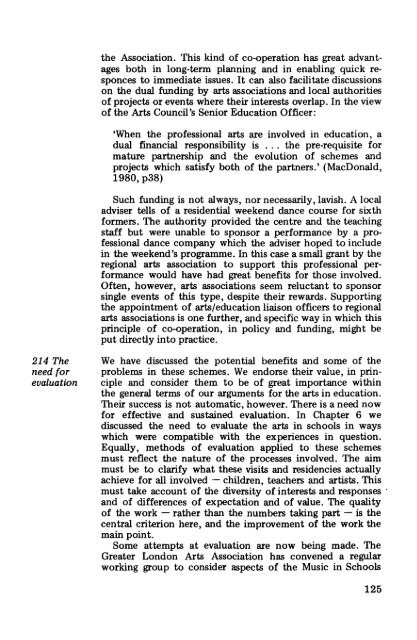The Arts in Schools - Calouste Gulbenkian Foundation
The Arts in Schools - Calouste Gulbenkian Foundation
The Arts in Schools - Calouste Gulbenkian Foundation
- No tags were found...
Create successful ePaper yourself
Turn your PDF publications into a flip-book with our unique Google optimized e-Paper software.
the Association. This k<strong>in</strong>d of co-operation has great advantagesboth <strong>in</strong> long-term plann<strong>in</strong>g and <strong>in</strong> enabl<strong>in</strong>g quick responcesto immediate issues. It can also facilitate discussionson the dual fund<strong>in</strong>g by arts associations and local authoritiesof projects or events where their <strong>in</strong>terests overlap. In the viewof the <strong>Arts</strong> Council's Senior Education Officer:'When the professional arts are <strong>in</strong>volved <strong>in</strong> education, adual f<strong>in</strong>ancial responsibility is ... the pre-requisite formature partnership and the evolution of schemes andprojects which satisfy both of the partners.' (MacDonald,1980,p38)Such fund<strong>in</strong>g is not always, nor necessarily, lavish. A localadviser tells of a residential weekend dance course for sixthformers. <strong>The</strong> authority provided the centre and the teach<strong>in</strong>gstaff but were unable to sponsor a performance by a professionaldance company which the adviser hoped to <strong>in</strong>clude<strong>in</strong> the weekend's programme. In this case a small grant by theregional arts association to support this professional performancewould have had great benefits for those <strong>in</strong>volved.Often, however, arts associations seem reluctant to sponsors<strong>in</strong>gle events of this type, despite their rewards. Support<strong>in</strong>gthe appo<strong>in</strong>tment of arts/education liaison officers to regionalarts associations is one further, and specific way <strong>in</strong> which thispr<strong>in</strong>ciple of co-operation, <strong>in</strong> policy and fund<strong>in</strong>g, might beput directly <strong>in</strong>to practice.214 <strong>The</strong> We have discussed the potential benefits and some of theneed for problems <strong>in</strong> these schemes. We endorse their value, <strong>in</strong> pr<strong>in</strong>evaluationciple and consider them to be of great importance with<strong>in</strong>the general terms of our arguments for the arts <strong>in</strong> education.<strong>The</strong>ir success is not automatic, however. <strong>The</strong>re is a need nowfor effective and susta<strong>in</strong>ed evaluation. In Chapter 6 wediscussed the need to evaluate the arts <strong>in</strong> schools <strong>in</strong> wayswhich were compatible with the experiences <strong>in</strong> question.Equally, methods of evaluation applied to these schemesmust reflect the nature of the processes <strong>in</strong>volved. <strong>The</strong> aimmust be to clarify what these visits and residencies actuallyachieve for all <strong>in</strong>volved — children, teachers and artists. Thismust take account of the diversity of <strong>in</strong>terests and responsesand of differences of expectation and of value. <strong>The</strong> qualityof the work — rather than the numbers tak<strong>in</strong>g part — is thecentral criterion here, and the improvement of the work thema<strong>in</strong> po<strong>in</strong>t.Some attempts at evaluation are now be<strong>in</strong>g made. <strong>The</strong>Greater London <strong>Arts</strong> Association has convened a regularwork<strong>in</strong>g group to consider aspects of the Music <strong>in</strong> <strong>Schools</strong>125
















